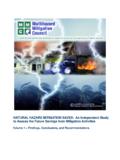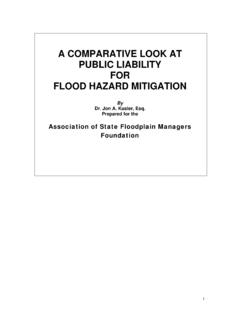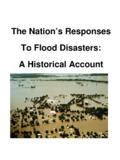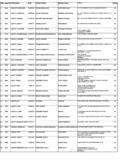Transcription of National Flood Insurance Program Insurance …
1 National Flood Insurance ProgramInsurance Agent s Lowest floor GuideWHERE TO following are some suggested guidelines for interpreting the elevation information in Section C:STEP 1: Review the Elevation Certificate. Find the referenced Building Diagram Number in Section A, Item A7. This diagram number refers to one of the building diagrams located on Instructions Pages 7-9 of the Elevation 2:Once the correct building diagram has been determined, review the data contained in Section C, Item C2 of the Elevation Certificate. The circled letters and numbers on the building diagram correspond to the elevations entered in Items C2. a-h in Section C, Item C2. Check the Lowest floor Guide found on the inside of this brochure as well as in the Flood Insurance 3:Review the Elevation in Item If the elevation in Item is lower than the elevation in Item , then you have a building with a basement.
2 The correct lowest floor elevation rating will be Item (Building Diagrams 2, 4, or 9). For Building Diagrams 1A, 1B, and 3, if Item is higher than , the building is slab on grade, or a walkout first level. Rate as no basement and use Item as the lowest floor elevation for rating. If Item is given, and the property is in a V Zone, Item will be the correct lowest floor elevation for rating if there are no enclosures (Building Diagram 5). If Item is higher than Item , then you have an elevated building with enclosure(s) below the elevated level. Use Item as the lowest floor elevation for rating V Zones if the enclosure is less than 300 sq. ft., the walls are breakaway, and machinery and equipment are elevated at or above the BFE.
3 Otherwise use the bottom of Item if the enclosure is 300 sq. ft. or greater, the walls are supporting walls, or machinery and equipment are below the BFE and an enclosure of any size exists (Building Diagram 6). IMPORTANT HINT: If Item A8 and/or Item A9 shows Flood openings, and the openings are adequate for the square footage of the enclosed area, then you have an elevated building with proper venting. The lowest floor elevation for rating is Item , top of the next higher floor , as long as the building is not located in a V Zone (Building Diagrams 7 and 8).WHERE TO GET HELPThe Lowest floor Guide will assist you in determining the lowest floor for rating purposes for the majority of your business.
4 However, if you are unable to make the determination, contact your WYO Company underwriting staff or, for NFIP direct policies, the NFIP Servicing Agent underwriting department for IT INTO A and C of the 2009 Elevation Certificate provide fields for entering numerous measurements that the surveyor must record in completing an elevation survey. This data will be used to not only help Insurance agents accurately rate a Flood Insurance policy, but also assist FEMA and the local communities with their floodplain management compliance issues. The 2009 Elevation Certificate does not specifically identify the Lowest floor Elevation that must be used for rating purposes. Based upon your knowledge of the rules and regulations of the National Flood Insurance Program , you must make the final determinations regarding which elevation should be used to accurately rate the policy and calculate the premium.
5 This guide must be used in conjunction with information provided on the Flood Insurance Application guide will provide you with some helpful information and Agent s Lowest floor GuideLowest floor Guide for Zones A, AE, A1-A30, AH, AR, AR DualBUILDING DIAGRAM #1 ADistinguishing Feature: The bottom floor is at or above ground level (grade) on at least one side.*Lowest floor for Rating: Top of slab or lower attached garage if it has machinery and equipment below BFE unless the garage is properly ventedElevation Needed for Rating from FEMA Elevation Certificate: Item or Item (if structure has attached garage)All slab-on-grade single- and multiple- floor buildings (other than split-level) and high-rise buildings, either detached or row type ( , townhouses); with or without attached DIAGRAM #1 BDistinguishing Feature: The bottom floor is at or above ground level (grade) on at least one side.
6 *Lowest floor for Rating: Top of slab or lower attached garage if it has machinery and equipment below BFE unless the garage is properly vented Elevation Needed for Rating from FEMA Elevation Certificate: Item or Item (if structure has attached garage)All raised slab-on-grade or slab-on-stem-wall-with-fill single- and multiple- floor buildings (other than split-level) and high-rise buildings, either detached or row type ( , townhouses); with or without attached DIAGRAM #2 Distinguishing Feature: The bottom floor (basement or underground garage) is below ground level (grade) on all sides.*Lowest floor for Rating: Top of basement floorElevation Needed for Rating from FEMA Elevation Certificate: Item All single- and multiple- floor buildings with basement (other than split-level) and high-rise buildings with basement, either detached or row type ( , townhouses); with or without attached garage.
7 BUILDING DIAGRAM #3 Distinguishing Feature: The bottom floor (excluding garage) is at or above ground level (grade) on at least one side.*Lowest floor for Rating: Top of slabElevation Needed for Rating from FEMA Elevation Certificate: Item All split-level buildings that are slab-on-grade, either detached or row type ( , townhouses); with or without attached DIAGRAM #4 Distinguishing Feature: The bottom floor (basement or underground garage) is below ground level (grade) on all sides.*Lowest floor for Rating: Top of slab (basement floor )Elevation Needed for Rating from FEMA Elevation Certificate: Item All split-level buildings (other than slab-on-grade), either detached or row type ( , townhouses); with or without attached floor Guide for Zones A, AE, A1-A30, AH, AR, AR DualBUILDING DIAGRAM #5 Distinguishing Feature: The area below the elevated floor is open, with no obstruction to flow of floodwaters (open lattice work and/or insect screening is permissible).
8 Lowest floor for Rating: Lowest elevated floorElevation Needed for Rating from FEMA Elevation Certificate: Item All buildings elevated on piers, posts, piles, columns, or parallel shear walls. No obstructions below the elevated DIAGRAM #6 Distinguishing Feature: The area below the elevated floor is enclosed, either partially or fully. In A Zones, the partially or fully enclosed area below the elevated floor is with or without openings** present in the walls of the floor for Rating: Lowest elevated floor or top of bottom floor if conditions in the Flood Insurance Manual are metElevation Needed for Rating from FEMA Elevation Certificate: Item or Item buildings elevated on piers, posts, piles, columns, or parallel shear walls with full or partial enclosure below the elevated DIAGRAM #7 Distinguishing Feature: The area below the elevated floor is enclosed, either partially or fully.
9 In A Zones, the partially or fully enclosed area below the elevated floor is with or without openings** present in the walls of the floor for Rating: Lowest elevated floor or top of bottom floor if conditions in the Flood Insurance Manual are metElevation Needed for Rating from FEMA Elevation Certificate: Item or Item buildings elevated on full-story foundation walls with a partially or fully enclosed area below the elevated floor . This includes walkout levels, where at least one side is at or above grade. The principal use of this building is located in the elevated floors of the DIAGRAM #8 Distinguishing Feature: The area below the first floor is enclosed by solid or partial perimeter walls.
10 In A Zones, the crawlspace is with or without openings** present in the walls of the floor for Rating: Next higher floor or top of bottom floor if conditions in the Flood Insurance Manual (Lowest floor Determination) for A zones are metElevation Needed for Rating from FEMA Elevation Certificate: Item or Item buildings elevated on a crawlspace with the floor of the crawlspace at or above grade on at least one side, with or without attached DIAGRAM #9 Distinguishing Feature: The bottom (crawlspace) floor is at or below ground level (grade) on all sides.* (If the distance from the crawlspace floor to the top of the next higher floor is more than 5 feet, or the crawlspace floor is more than 2 feet below the grade (LAG) on all sides, use Diagram 2.)

















